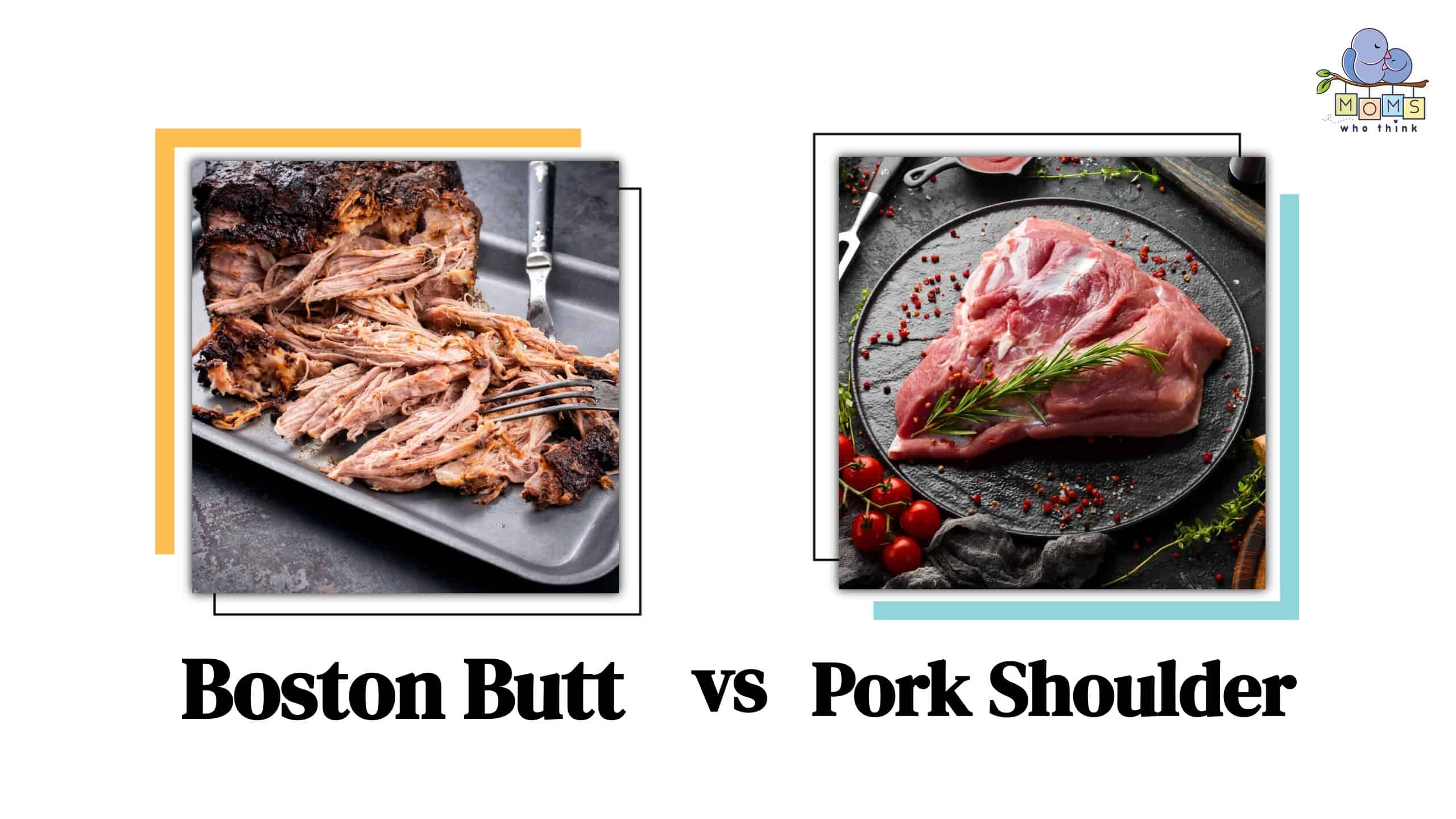Walking into the grocery store and coming face to face with all the meat choices can feel overwhelming. What are the differences between all of the diverse cuts? How do you know which one is the right one? If you have ever wondered about the difference between a Boston butt and pork shoulder, this post will answer those questions!
The main difference between pork shoulder and Boston butt is the location of the two types of meat. However, before you start thinking, “Aha! Boston butt is from the butt of the pig, and pork shoulder is from the shoulder,” it's necessary to know both of these cuts are from the shoulder of the pig! Boston butt is higher up on the shoulder. On the other hand, the pork shoulder is lower, closer to the foreleg. Read on for more significant differences between the two.
Boston Butt vs. Pork Shoulder: What are the Differences?
Boston butt comes from high up on the pig's shoulder. This portion includes the neck, shoulder blade, and upper leg. These areas have high-fat content and plenty of marbling dispersed throughout. However, the pork, or picnic, shoulder comes from the area of the pig's shoulder that sits right above the foreleg. As a result, it is a triangle shape and much thinner than Boston butt. It also does not have as much marbling as Boston butt and doesn't contain as much fat content.
- The must-have convenient reference guide for every home cook!
- Includes more than 8,000 substitutions for ingredients, cookware, and techniques.
- Save time and money on by avoiding trips to grab that "missing" ingredient you don't really need.
Boston butt and pork shoulder both have a sweet flavor undertone. They are also salty, rich, and a bit gamey in taste. However, even though they have similar tastes, the cooking methods of the two are different.
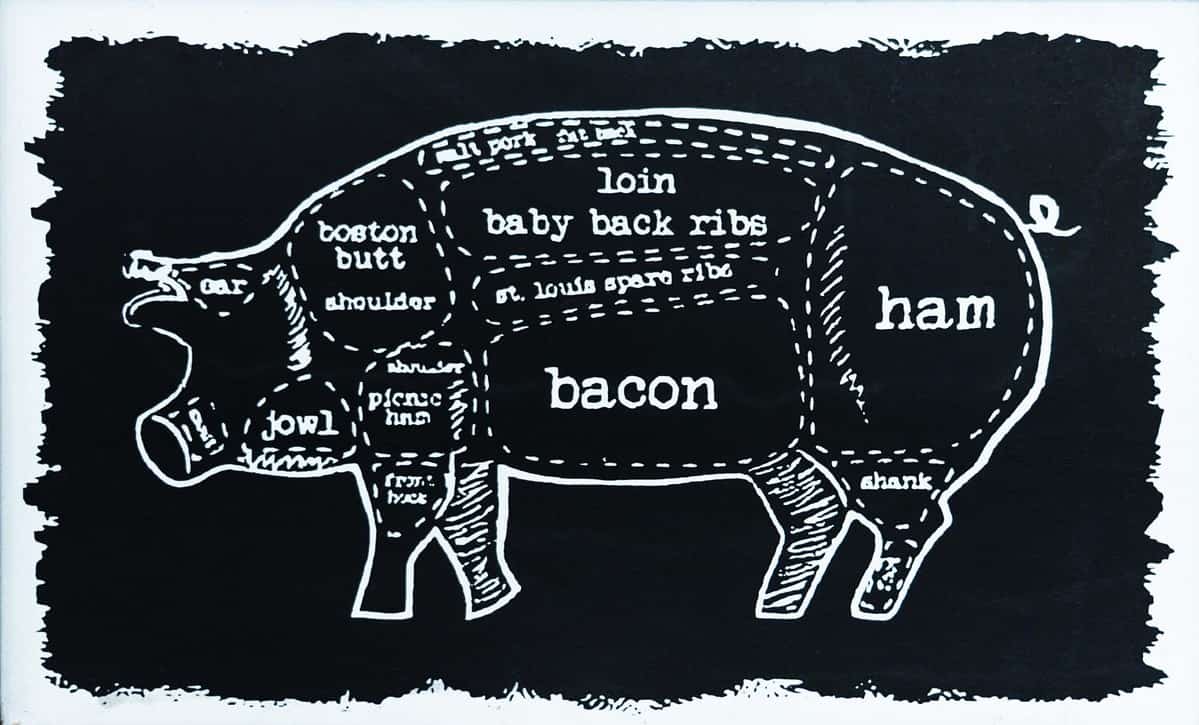
This illustration is a great way to see the different areas that Boston butt and pork shoulder derive from.
©Lamai Prasitsuwan/Shutterstock.com
Cooking Methods
When it comes to the cooking methods of these two cuts of meat, they vary. Boston butt takes very well to slow-cooking methods. This is because of the high marbling and fat content. Slow cooking methods allow the fat to melt and create a tender, savory flavor. Boston butt is particularly great for barbequed pulled pork or slow-roasted pork. When roasted or stewed, slow cooking will produce meat that falls apart easily and is very delicate but rich in meaty flavor.
Pork shoulder, on the other hand, is an excellent meat when you need one to hold form. It slices and dices very well and will retain shape. Pork shoulder also resembles ham in a way. It still cooks or roasts slowly, much like Boston butt, and produces a salty, intense, rich, and meaty flavor with a sweet undertone.
Boston Butt vs. Pork Shoulder Nutritional Value
Regarding nutritional value, both of these meats are very similar. They are higher in calories but are also excellent sources of protein. Take a look below at the nutritional facts and comparison of the two!
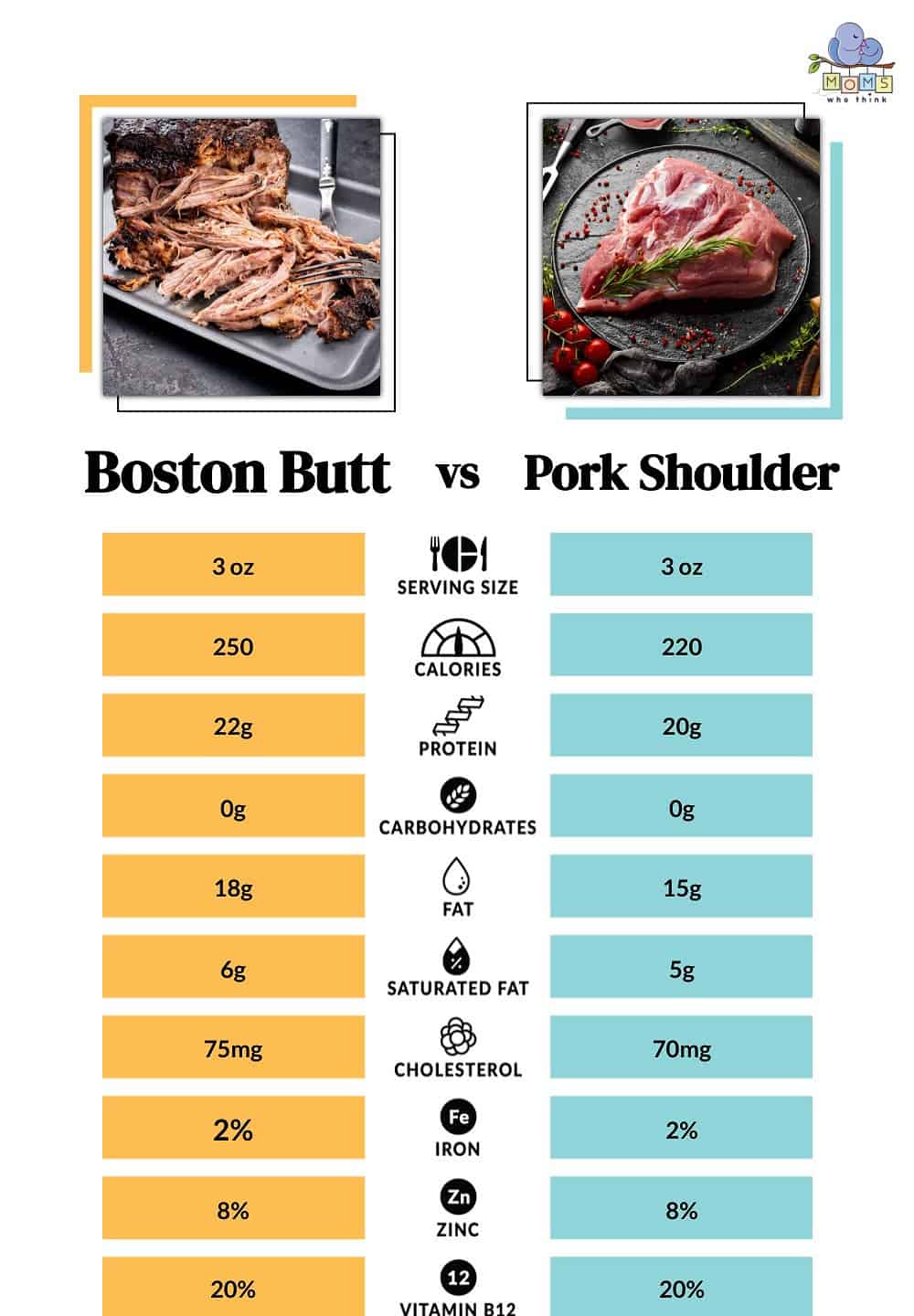
©
What Is Boston Butt?
When you hear the word Boston butt, you may think it comes from the back of the pig. However, Boston butt is a high-quality meat that comes higher up on the shoulder of a pig. It includes the neck, shoulder blade, and a little of the front leg. The high marbling and fat content means the meat is tender and falls apart when cooked slowly.
The meat will be succulent and tender when Boston butt cooks correctly. Another name is pork butt. So, where exactly does the name Boston butt come from? Many say the name derives from butchers in New England storing this meat in barrels or butts (the name of the barrels!) and shipping them off.
When it comes to finding the perfect Boston butt for your meal, there are many factors to consider. The first is whether you want to bone in or out. You can purchase either one. When you buy a bone-in Boston butt, it will have more savor. However, it needs a slower cooking method. Another consideration is the marbling. The higher the fat content and marbling it has, the juicier the meat will be. The fat will soften, moisten the meat and produce fatty flavors.
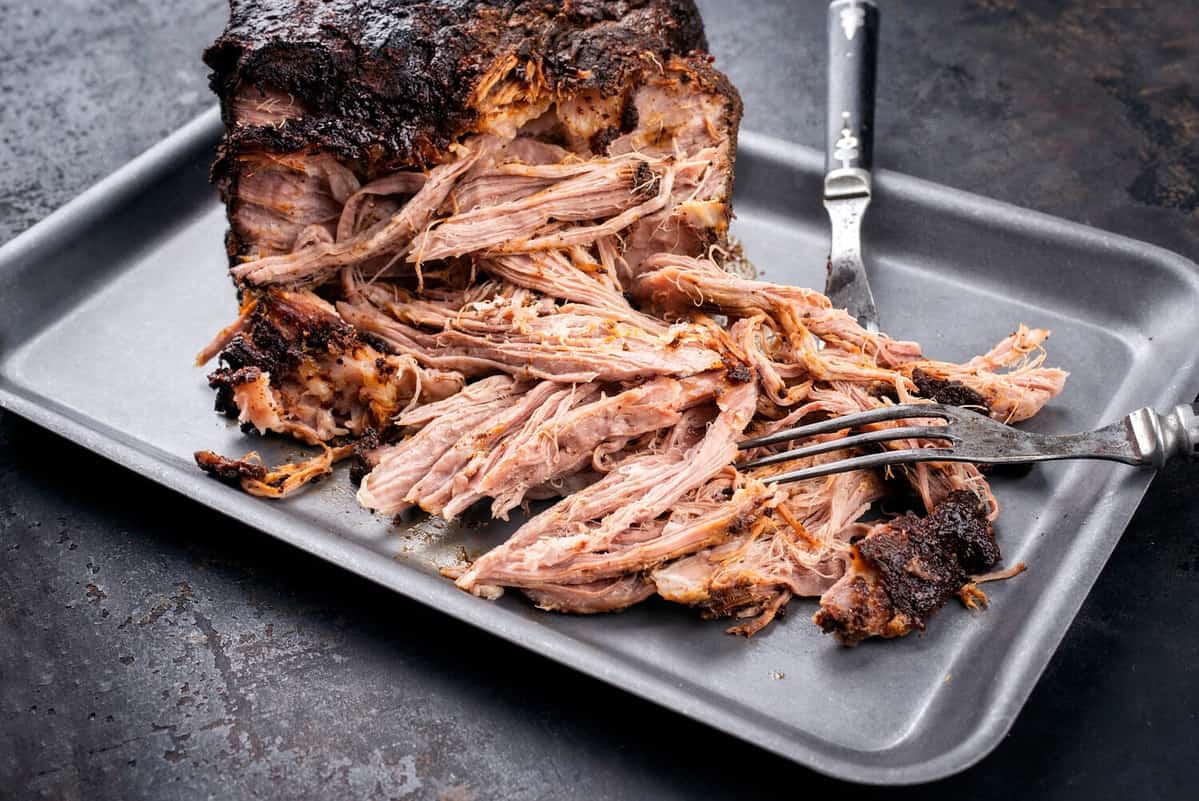
Boston butt is excellent for BBQ pulled pork because it shreds easily and is tender.
©hlphoto/Shutterstock.com
What is Pork Shoulder?
Pork shoulder has another name: picnic shoulder or picnic roast. It comes from the lower part of a pig's shoulder, right above the front leg. It is triangle-shaped and has less marbling and fat than Boston butt. However, it can have a tough texture if cooked incorrectly. Also, the flavor is sweet, meaty, and, when cooked correctly, juicy.
The pork shoulder holds its shape very well. It is excellent for slicing into ham pieces or dicing up for stew. The texture is not as tender as Boston butt. However, it still produces delicious and mouthwatering meat.
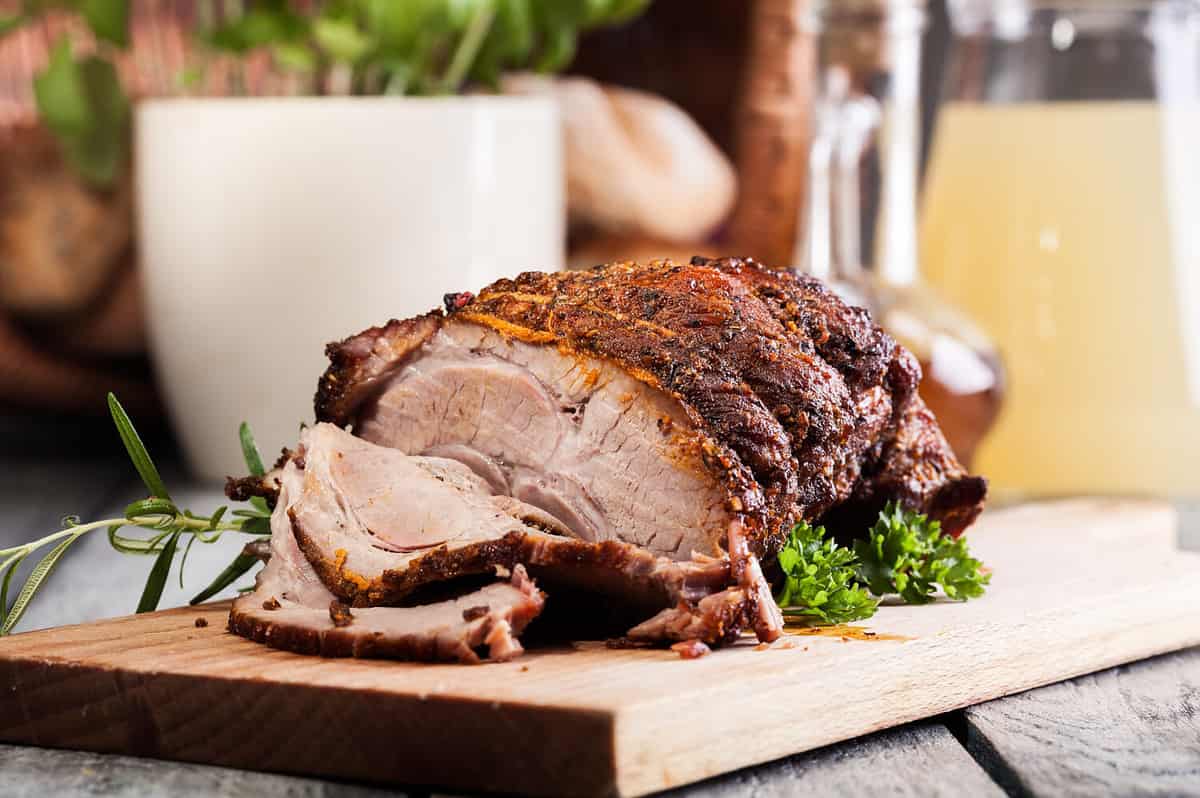
Pork shoulder is easy to slice, much like a ham.
©Slawomir Fajer/Shutterstock.com
Can You Substitute Boston Butt for Pork Shoulder?
Although Boston butt and pork shoulder are very similar in location regarding where they are cut from, they do not make suitable substitutes for one another. This is because the texture and firmness of both are different.
- The must-have convenient reference guide for every home cook!
- Includes more than 8,000 substitutions for ingredients, cookware, and techniques.
- Save time and money on by avoiding trips to grab that "missing" ingredient you don't really need.
Boston butt makes excellent meat for meals such as pulled pork. When cooked slowly, the fat content produces a fall off the fork-tender meat that is great for shredding.
Pork shoulder, however, holds shape and doesn't produce the same result when shredding up. However, if you are looking for substitutes, there are a few that you can consider!
What are Substitutes for Boston Butt?
Substitutes for Boston butt would be any delicious meat that takes well to slow roasting or cooking and can be shredded easily with a fork when done. If you want the perfect substitute, try the beef brisket, chuck roast, rump roast, or skirt steak.
Although the texture and taste of these substitutes will vary, many will still produce the same flavor and tenderness as pork butt does.
What are Substitutes for Pork Shoulder?
If you are looking for a substitute for pork shoulder, you likely want meat that will hold shape and still produce a delectable and juicy meal. A few considerations are sirloin steak, lamb shoulder, or chicken thighs. All of these take well to slow roasting or cooking, resulting in juicy and mouthwatering meat that sends your taste buds dancing.
In Conclusion
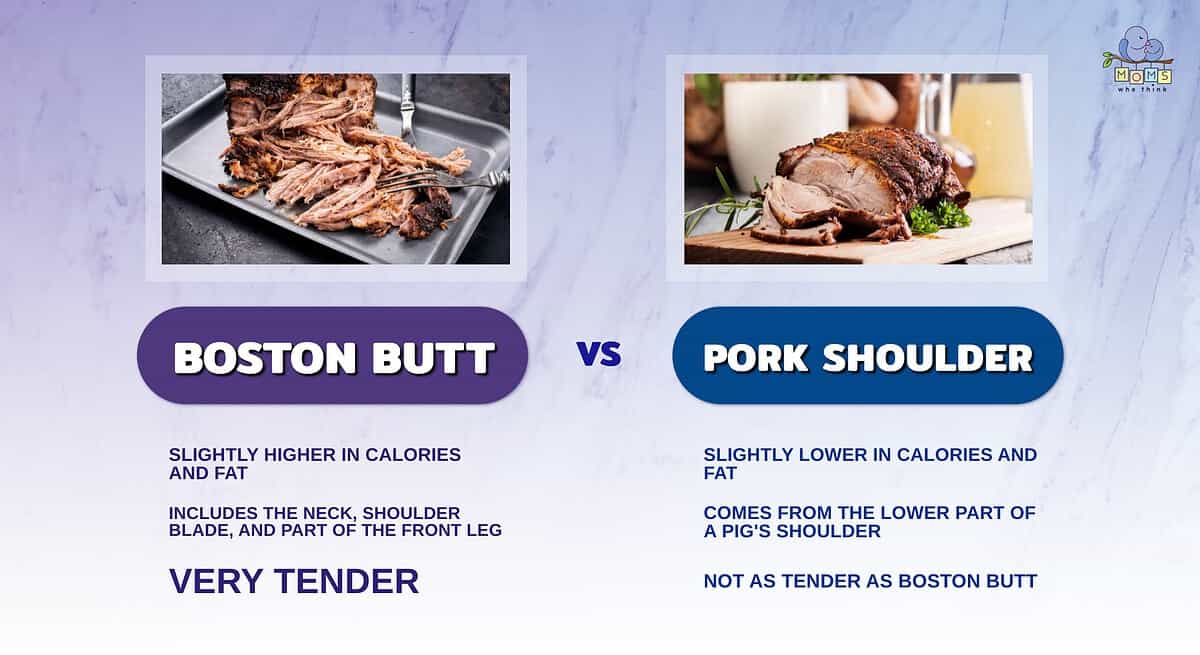
- Boston butt is slightly higher in calories and fat than pork shoulder. Neither of them are stand-out health foods, though they both have a good amount of protein.
- The Boston butt comes from the neck, shoulder blade, and part of the front leg of the pig. The pork shoulder, meanwhile, comes from the lower part of the pig's shoulder. The location the Boston butt comes from is higher in fat.
- Because the Boston butt is higher in fat, it is more tender than a pork shoulder. Don't think a pork shoulder is tough and gamey, though; in fact, it's still quite mouthwatering and juicy.
Although they may seem similar, Boston butt and pork shoulder have some fundamental differences that are important to remember. Boston butt is a delicious, tender cut of meat from the top of a pig's shoulder. It does not get quite as much exercise while the pig is alive. This means that the meat is full of high-fat content and marbling. The fat and marbling mean that when slow-cooked, Boston butt becomes very tender and juicy and falls off a fork easily, making it perfect for meals like barbequed pulled pork.
On the other hand, the pork shoulder comes from the lower part of a pig's shoulder right above the front leg. The front leg does get plenty of exercise while the pig is alive. Therefore, there is less marbling or fat content. When not cooked correctly, pork shoulder can be tough. However, when cooked correctly, pork shoulder produces juicy, sweet, and tender meat that pairs well with many sides, like green beans or corn. The pork shoulder does not fall off the fork and cannot be shredded as easily as the Boston butt. Instead, pork shoulder is excellent for slicing or dicing.
What you choose is about personal preference when it comes to meat. However, there are a few factors to consider before buying pork. First, decide whether or not you would like meat that falls off the fork and shred or one that you can cut up. Consider the marbling and fat content as well. Both will contribute to how juicy and tender the result is. Regardless of which one you decide, one thing is sure: pork shoulder and Boston butt are sweet, tender, and juicy options that are great for dinner!
Pork Recipes
Print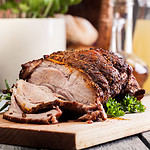
Pork Shoulder Steak
Ingredients
1 1/2 Tablespoons Hungarian paprika
1 Tablespoon ground coriander
1 Tablespoon finely grated lemon zest (zest from 1 lemon)
1 Tablespoon dried marjoram
2 teaspoons garlic powder
1 teaspoon salt
3/4 teaspoon freshly ground black pepper
1/2 teaspoon ground cumin
1/4 teaspoon caraway seeds, crushed
1/4 teaspoon ground cinnamon
8 boneless pork shoulder steaks, cut 3/4-inch thick
Instructions
- In a small bowl combine paprika, coriander, lemon zest, marjoram, garlic powder, salt, pepper, cumin, caraway seeds, and cinnamon.
- Rub herb mixture on both sides of steaks, pressing into surface. Place steaks in center of cooking grate.
- Grill 10 minutes for medium (160 degrees F) or 12 to 14 minutes for well-done (170 degrees F), turning once halfway through grilling time.
- 20 Side Dishes for Pulled Pork Sandwiches
- Down Home Pork Chops and Gravy Recipe
- Pork Schnitzel with Mushroom Gravy Recipe
- Pork with Spicy Orange Cranberry Sauce Recipe
- Brown Sugar Glazed Spiced Pork Loin Roast Recipe
